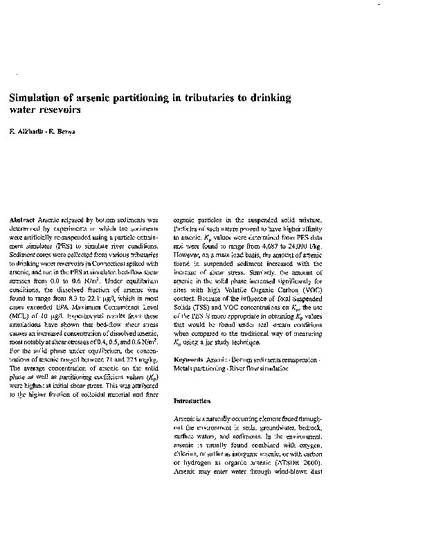
Arsenic released by bottom sediments was determined by experiments in which the sediments were artificially re-suspended using a particle entrapment simulator (PES) to simulate river conditions. Sediment cores were collected from various tributaries to drinking water reservoirs in Connecticut spiked with arsenic, and run in the PES at simulated bed-flow shear stresses from 0.0 to 0.6 N/m2. Under equilibrium conditions, the dissolved fraction of arsenic was found to range from 8.3 to 22.1 ug/1, which in most cases exceeded EPA Maximum Contaminant Level (MCL) of 10 ug/1. Experimental results from these simulations have shown that bed-flow shear stress causes an increased concentration of dissolved arsenic, most notably at shear stresses of 0.4,0.5, and 0.6 N/m2. For the solid phase under equilibrium, the concentrations of arsenic ranged between 71 and 275 mg/kg. The average concentration of arsenic on the solid phase as well as partitioning coefficient values (Kp) were highest at initial shear stress. This was attributed to the higher fraction of colloidal material and finer organic particles in the suspended solid mixture. Particles of such nature proved to have higher affinity to arsenic. Kp values were determined from PES data and were found to range from 4,687 to 24,090 1/kg. However, on a mass load basis, the amount of arsenic found in suspended sediment increased with the increase of shear stress. Similarly, the amount of arsenic in the solid phase increased significantly for sites with high Volatile Organic Carbon (VOC) content. Because of the influence of Total Suspended Solids (TSS) and VOC concentrations on Kp, the use of the PES is more appropriate in obtaining Kp values that would be found under real stream conditions when compared to the traditional way of measuring Kp using a jar study technique.
Available at: http://works.bepress.com/eid_alkhatib/3/

The original publication is available at www.springerlink.com
Alkhatib, E., & Berna, E. (2008). Simulation of arsenic partitioning in tributaries to drinking water resevoirs. Environmental Monitoring and Assessment, 137(1-3), 197-204. doi: http://dx.doi.org/10.1007/s10661-007-9740-0